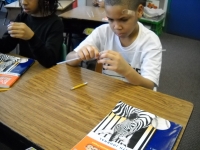Learning by Moving and Manipulating

“Different children learn differently,” explains Stacy Kroger, Canterbury Elementary third grade teacher. In her classroom, students work in small groups, in pairs, or independently at specially prepared stations. “I know that hands-on activities and movement demonstrations allow some students to grasp concepts faster, so I incorporate them into lessons whenever possible.”
She begins a math lesson by asking students what they remember from previous lessons about lines, line segments, and rays. Kroger introduces the concept of angles and moves her body to show the class how angles change: a quarter turn, a half turn, and a full clockwise turn. The students stand and follow her prompts to make various angles. The movements require control and concentration.
Now, the students are ready to form angles with a pair of straws connected at the vertex by a twist-tie. The teacher demonstrates how to make a quarter turn clockwise with her straws, and reminds them that it is called a right angle. She slowly walks through the classroom observing their work. As the students gain confidence, she asks them to make more challenging angles ― obtuse and acute.
A typical week includes whole class activities, team teaching and parallel teaching with a special education teacher. “Everyone seems to benefit from being more involved,” explained Kroger. “A variety of learning groups and a mixture of activities keep everyone engaged which mean more success.”
